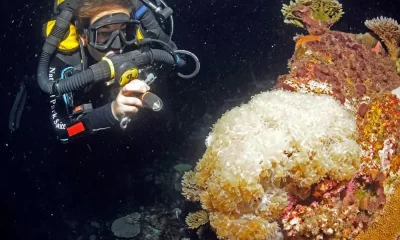
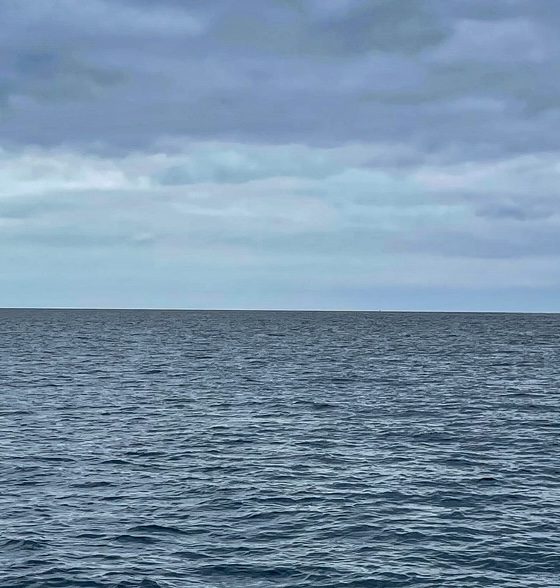
Community
Diving Rocks! The Traverse from Ship Rock to Bird Rock
Tech instructor and musico Francesco Cameli reports on a recent team dive traversing the two humongous rocks that bookmark the San Pedro Channel, max depth 70m/230 ft. Power up your DPV; you’re in for a 1189m/3900ft ride!
by Francesco Cameli. Images courtesy of the team unless noted.
🎶 Predive Clicklist: “We will, we will rock you, rock you. We will, we will rock you, rock you”—Queen 🎶
Well, I wish I could say it was my idea, but it was not. It was, in fact, one of my favourite team mates Jim Babor who came up with it. In his mind, he had been wanting to do this for a couple of years. It looked doable, but he hadn’t done the research to figure out if in fact that was true. It was in fact doable.
So, about six months ago with the pandemic in full bloom and Jim out of work, he decided to open a chart of Catalina Island (Two Harbors, specifically) and see what we would be looking at for depth and distance.
The chart said a max depth of 76 m/250 ft and a distance of about 1189 m/3900 ft. Based on that, the traverse seemed totally doable with time to spare!
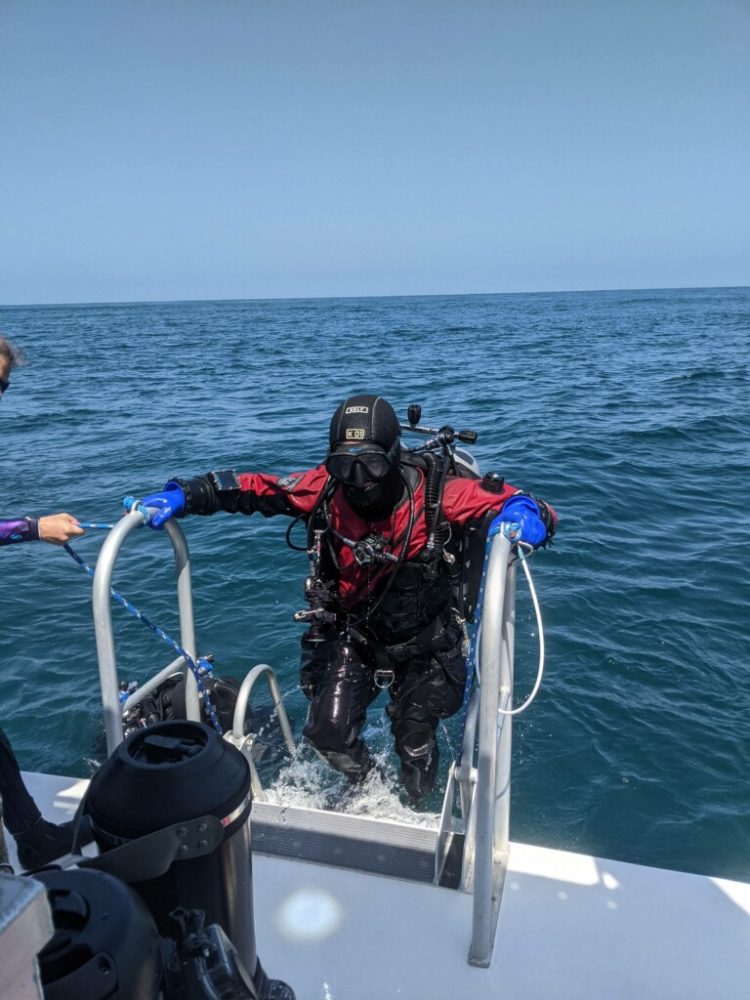
He originally planned on 46 m/150 ft a minute on the scooters once we started, as long as there was no current. Big Blue, the boat we used, had actually run the course about a month before the dive and confirmed that the max depth was right at 70 m/230 ft, and the deepest part would happen in the first third. The bottom is shaped like a “V” so it would be easy to plan the dive and the decompression.
Now that he had an idea the dive could be done he had to get six divers that could, and wanted to, do the dive. So, he reached out to David Watson, Mark Self, Karim Hamza, Nir Maimon, and me. We all agreed to the 230 feet max depth with no more than a 60 minutes decompression obligation. Travel time would be 26 minutes, but we agreed to travel for 35 minutes max in case we needed extra time to find Bird Rock. We could still travel and do our accumulated deco—at that point anyway.
One final thing about the plan: navigation. Jim really wanted Karim to navigate because he’d been on many project based dives with him, and Karim is super reliable always, and on target.
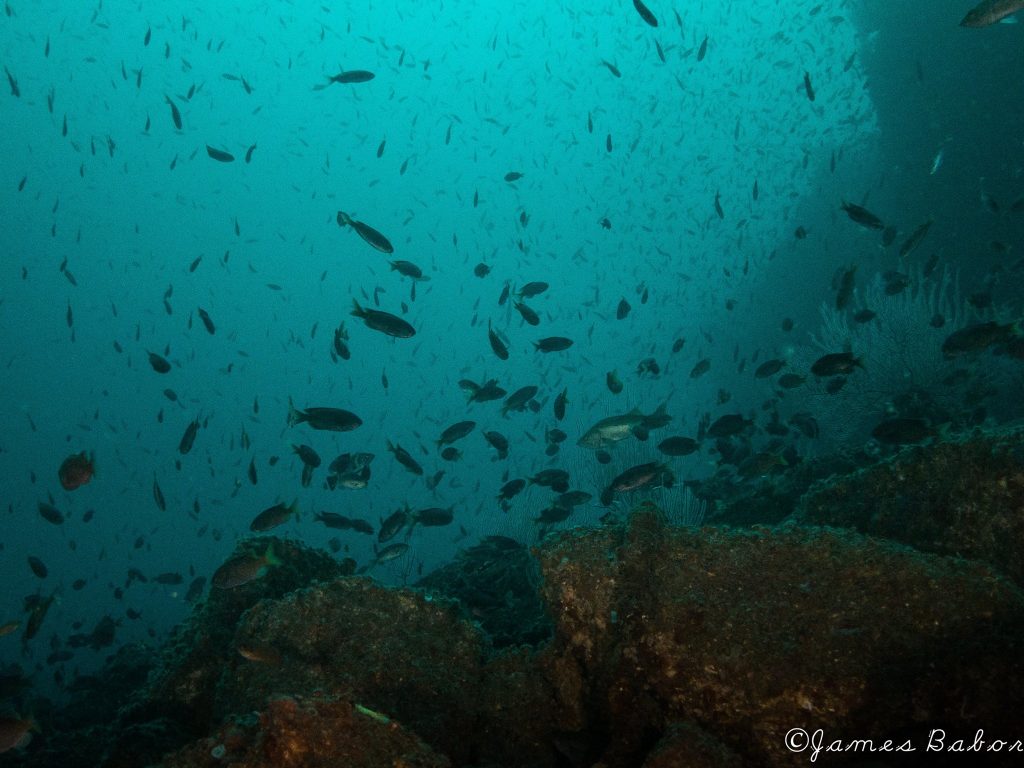
In the morning when we got to the site, we ran the course one final time in the boat. We briefed and made it clear that one person would navigate and one person would verify—Watson—and that we would not navigate by committee. The hardest part about that is just not doubting yourself and your compass along the way, which is something we talked about before we jumped in. You see both the starting point and finishing point are two firm Los Angeles Underwater Explorers (LAUE) favorite dive spots.
Location Location, Location
SHIP ROCK is a small pinnacle that protrudes out of the water just offshore from Two Harbours in Catalina. It lies off the Isthmus about two miles. It takes its name from its great resemblance to a ship under full sail.
The top hundred feet under the pinnacle are nice enough, but it’s beyond 30m/100 feet, in my opinion, that it truly becomes magical with structure down to the sand at 52 m/170 feet and plenty of outcrops at 55m/180 ft, 61m/200ft to 77m/250 ft. It is also at times visited by a large great white which the locals call the landlord, although no one can be sure it is always the same shark or merely a term used to describe the different ones that frequent it. I have yet to see one there. All that said, it makes a great site for recreational and technical divers alike.
BIRD ROCK: Lays about a half-mile off Fisherman’s Cove, it appears above the channel waters as an oval, rounded, cemented rock about 91m/300ft by 152m/500 feet in extent and 6m/20 feet high. The rock is white with guano and is bare except for a limited patch of vegetation on the southeast side. The vegetation consists mostly of Opuntia among which grows about forty individuals of Cosmos gigantea, six shrubs of Lavatera, and a few plants of Malva rotundifolia. This rock is doubtless the original Catalina station for Lavatera and the place where it grows naturally.
This site, on the other hand, is only good to 49 m/160 ft or so, but to say only good, is not fair. The site itself is stunning with a great shelf at about 6m/20 feet which makes a great spot to end deco and is frequently visited by sea lions that love to play around as you pass the time before surfacing.
It’s only downside, due to the amount of bird guano, is that Bird Rock smells somewhat unpleasant!
We spent so much time diving these two sites, I’m kind of surprised no one thought of doing this until now.
The Final challenge was the boat captain and crew. Jim had been in constant contact with Captain Sheldon beforehand, and he was nervous about us doing the dive mainly because we would go under (albeit at 61m/200 ft) the main boat lane in and out of Two Harbors. We all totally respected the Captain, and it was his boat, so if he didn’t want us to do it, we wouldn’t do it, no questions asked.
However, after educating him on our plan and informing him that if anything happened, we would not make a direct ascent to the surface (we would incur a deco obligation pretty soon into the dive anyway, before reaching the boat lane), the Captain was comfortable and on board with the plan.
Dive Logistics
As mentioned the team was made up of Jim, David, Karim, Nir, Mark and me. Sadly, Mark had his car broken into the night before, so he did not join us on the dive.
The two sites are separated by approximately 1189 m/3900 ft. The maximum depth we were expecting to see between the two was 70m/230 ft, and, in fact, we saw 69m/228. The expected travel time was 26 minutes with a rise 2/3rds of the way there up to 46m/150ft then back down to 55m/180 feet before climbing back up to the rock.
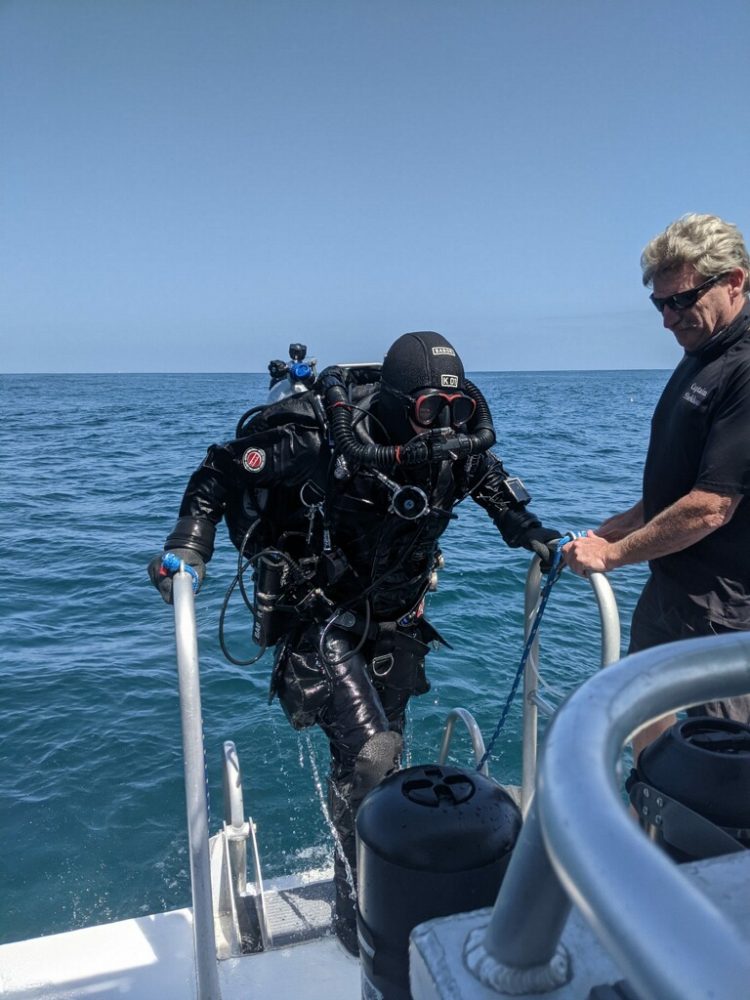
The plan was to take a heading and try to stick to it the best we could, while remembering to keep the underwater mound to our right as we passed it on route. If we missed the rock, we would hit the main island a few minutes later at another favourite spot called Blue Caverns. This is a series of caverns at about 70 to 80 feet on the face of Catalina island just outside of Two Harbours.
Due to Mark not making the dive we had four JJ-CCR (closed circuit rebreather) divers and one open circuit diver, so we decided to split into a group of three with the OC diver between two JJs and one team of two, but the plan was to all stick together as a group of five. So, we travelled as a reverse triangle, three at the front and two close in behind. The CCR divers wore their long hoses above the loop in case of necessity to donate, a common GUE practise in mixed teams.
At depth and in the darkness, it was easy to keep track of each other’s lights—not unlike on a cave dive. The formation kept together nicely with the occasional diver dropping all the way to the deck to check max depth and perhaps inspect an object or two that we passed along the way. The plan, however, was not to dilly-dally but rather to stay on course and on time!
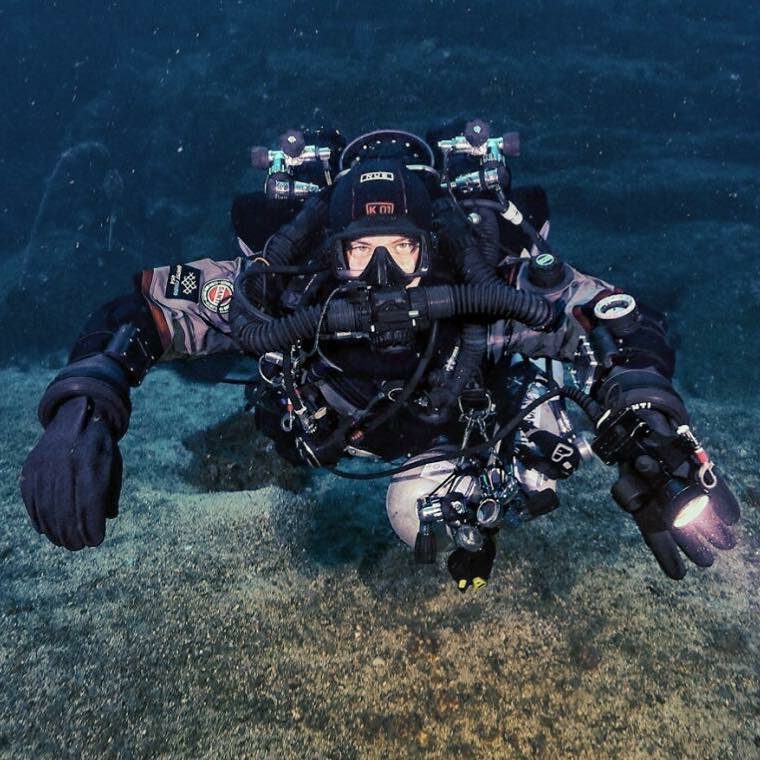
The JJs has trimix 12/65 diluent and bailout. In the GUE JJ configuration, there is a common set of doubles (LP50s in the states) which is both trimix bailout and dil. Additional bottom stages or deep deco gas can be carried in additional aluminum 80s (AL80) as required by depth and gas calculations. 50% and 100% were the deco gases. The open Circuit Diver was on trimix 15/55 with 50% and 100% deco gases. Every diver carried enough gas for the dive to ensure we had plenty in case of separation. Typically, as GUE divers we never dive with “team” bailout but always carry our full complement.
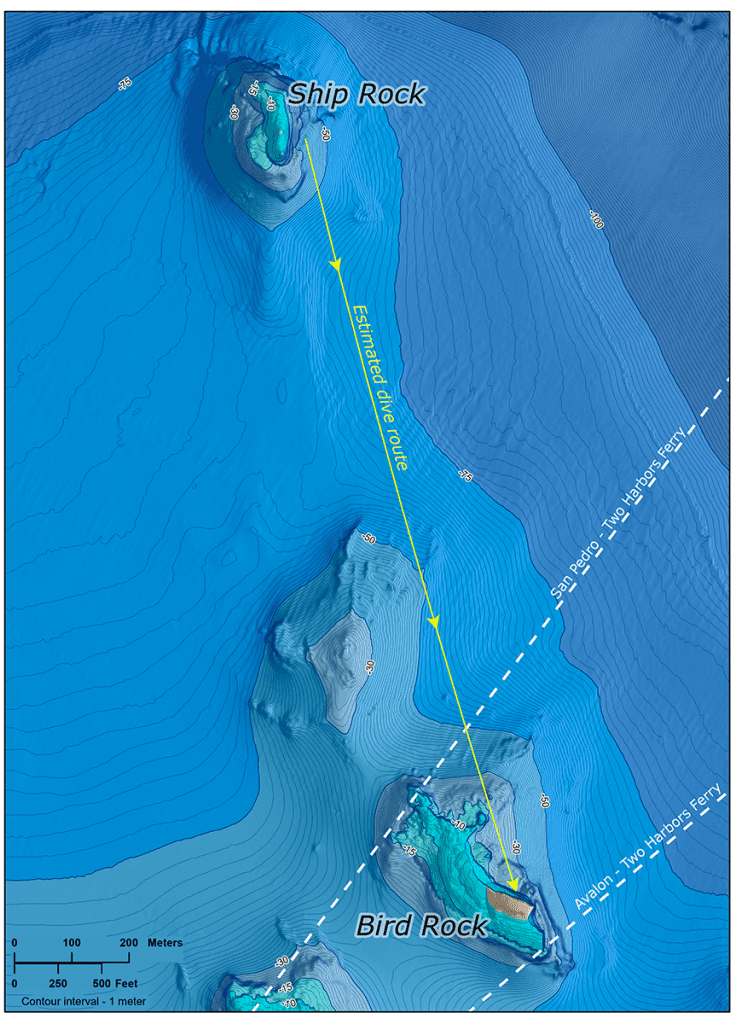
Traversing the Rocks
With all the planning done well ahead of dive day, we loaded the boat and took the one-hour ride to Ship Rock, where we anchored. After all our pre-dive checks and pre-breathes, we got into the water and took one last heading toward the rock to make sure. We dropped to 30 m/100 ft where we paused briefly to make sure all systems were good to go before heading to Bird.
Karim Hamza was given the task of navigating, so he aimed his DPV and we all speed matched. We were on our way!
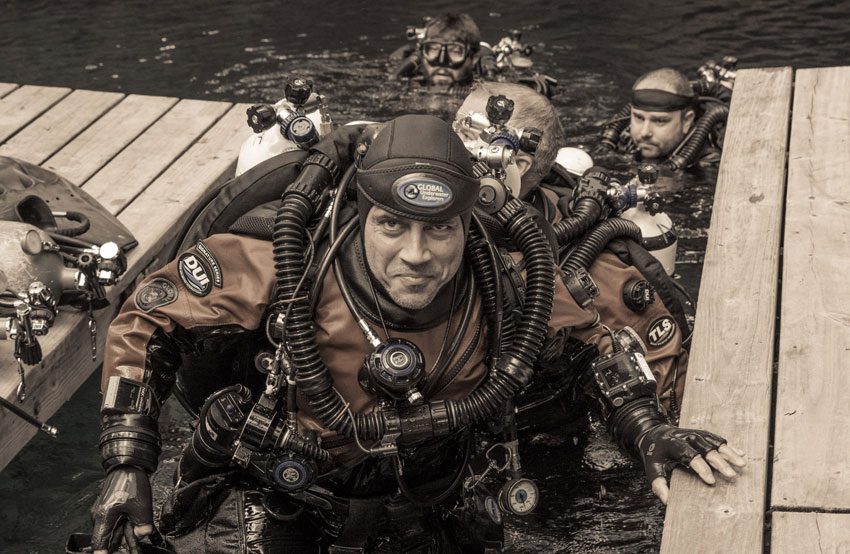
A few words from Karim as the navigator: “Jim had already done a run with the boat using the sonar. Based on that, we knew that our max depth would be around 230fsw. If we got deeper than that, we knew we were off course to the left, and if we got shallower at the wrong time, we knew we were off course to the right. Then we used certain depth markers, such as a shallow pinnacle before Bird Rock, as navigational waypoints. We made the decision to specifically use digital compasses, as the number and marker would be easier to follow.
We had a little confusion at the start since David, Jim, and I actually had different headings, which meant the digital compasses were not calibrated the same. After a quick discussion, we decided to each take a dead reckoning of Bird Rock, mark it, and use the marker as the direction of travel. The plan then was for me to navigate, for David to verify or backup my navigation, and for the others to follow. We did not want to navigate by committee underwater. One crucial thing that we discussed was the fact that after some time, we may start to doubt our navigation and where we were on the course. This, in a lot of ways, is the most critical point in the dive. It is important at this point of doubt to trust your own experience, your data, your compass, your teammates’ verification, and everything you planned to stay on course, and to not waver and miss your mark.
Once we started, we were on a time limit, and we did have to stop for a few minor issues; communication of scooter speed, one team member had a light issue that had to be resolved, and one team member decided to do a zig-zag sightseeing course along the way which was very distracting for me, as I was trying to stay on course navigating. I didn’t realize how distracting it was until we got back on the boat and discussed and debriefed the dive.
Finally, once we made it across—and along the way recognizing the landmarks we had planned for—we ended up on an upslope that came up to 36 m/120 ft on our right. This was not something we had planned and was confusing at first (this is where the self doubt starts to kick in). I decided at that point to take a 90 degree heading to the left, go back down to 46m/150 ft, turn right 90’ and after five minutes we were at a recognizable part of Bird Rock that we had all dived many times before.
From the 30m/100 ft shelf Ship Rock drops quickly to 70m/228 ft where it stayed for the first third of our journey. This took us along a mainly flat, sandy bottom with the odd dusting of medium rock and a large anchor that someone obviously lost. About nine minutes in, we started to climb, this was supposed to lead us past an underwater pinnacle that rises to some 18 m/60 ft, we were supposed to leave this to our right and climb to 46 m/150 ft. As it turned out, we had ended up on the right side of the mound, so at 34 m/110 ft, we were able to cross back over and drop back down to 55 m/180 ft as expected. At that point, we readjusted our heading back toward the rock.
The depth remained constant as expected for a few more minutes and then it started to climb with groups of rocks. Then, only three minutes behind schedule after our small detour, boom we hit the rock head on. We were at 34m/110 ft, and the sea lions confirmed we were on the right site. We were at a spot we call the aquarium—a firm favourite of mine, with multiple steps covered in lush Californian kelp. It is visually stunning and punctuated by playing sea pups. This led us to a wall which I have done many tech dives on. We kept the wall on our right and commenced our ascent along the wall.
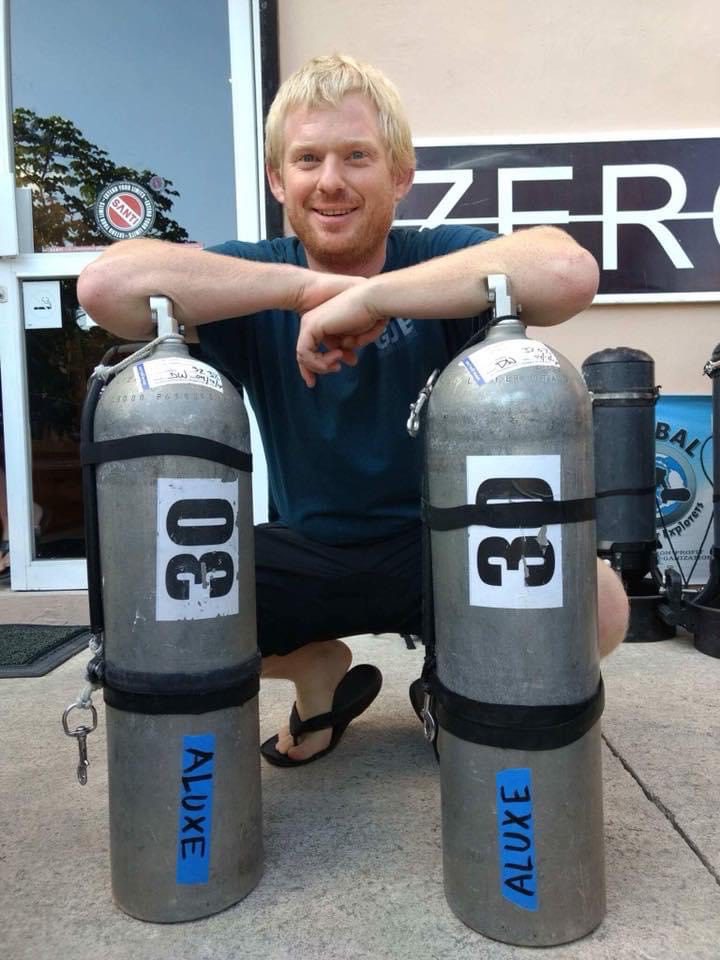
Deco was uneventful as planned with only David who was on open circuit doing his gas switches at 21m/70 ft to his 50% and 20 ft to pure O2. At 6m/20 ft we slowly kicked around passing the time in the kelp. Two minutes from surfacing, we deployed a surface marker buoy (SMB) and were met by the boat as we broke the surface.
As it turns out, with our average depth at 52m/170ft rounded to the nearest 3m/10 ft, the OC and CCR deco profiles tracked very closely, with the CCR divers obliging very slightly longer stops deeper to let the OC diver do his stops and vice versa at 6m/20 ft where an extra couple of minutes were required by the CCRs, so we all stayed together and did all the deco as a group. This was very much in keeping with what we had planned with our Deco Planner software before the dive. In the end, it was just a case of confirming which deco profile we were going to do based on our average depth and time.
Plan the Dive, Dive The Plan
We planned the dive and dove the plan with a small re-adjust of direction midway through. The team reacted calmly and got back on track as is expected of a well-oiled, high-functioning technical team. We realized we were on the wrong side, confirmed with brief hand gesture discussion, and rectified the situation to eventually end up exactly where we had planned. On we went, would we find the rock? Well, we could not have hit Bird Rock more dead on! Kudos Mr. Hamza for your navigation! And only three minutes past when we had calculated we would arrive.
On the whole, the dive was relaxed, uneventful, focused, and a lot of fun. Just how we like ‘em. Our total run time was about 100 minutes.
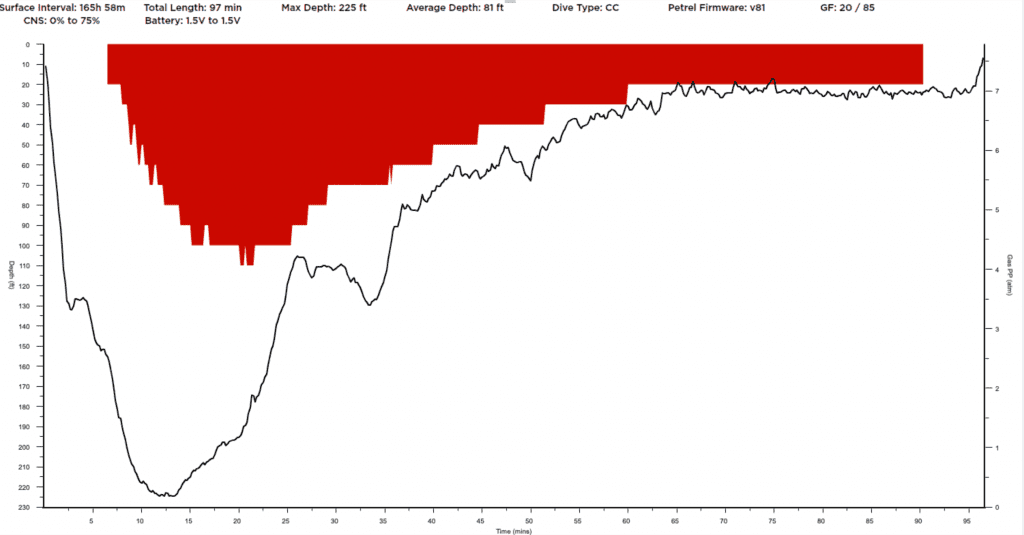
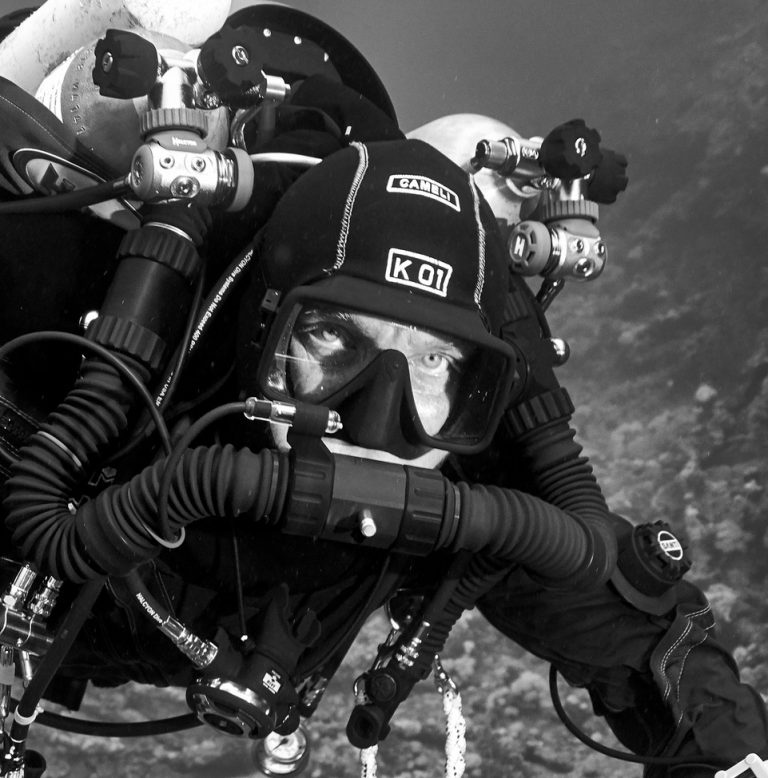
Unfortunately, we had no cameras or video of the dive. We didn’t think of it beforehand and, honestly, we all wanted to just be focused on what we were doing. Also, no top side photos. The only photos of us are the ones on Facebook of us all napping on the way back, haha! We would like to do it again at some point—take a go pro video of it and speed it up 10x’s and make a three-minute video out of the whole thing. Jim thought that might be cool. After a surface interval, we did a recreational dive on the nearby Isthmus reef. A great day of diving for all. Thanks to Big Blue’s Captain Sheldon Jones and our very own GUE diver and DM Nicole Coleman for the surface support.
One final note about GUE standard gasses. These have been formulated keeping a number of variables in mind. Max PO2, Max Density, Equivalent Narcotic Depth (END). These have been arranged and arrived at for easy memorization, as well as the ease of cross blending between them when the agency is on a project and they have been arranged into easy to remember and common depth ranges. The primary purpose for this standardization is to remove the guesswork and maintain team cohesion for deco. If everyone is on the same gas, then there should be no difference in deco obligation from team member to team member, making for an altogether safer ascent.
Typically, we try to maintain a PO2 of no more than 1.2 for the deep part of a tech dive with a max PO2 of 1.6 on deco. Also, 50% spikes at a 1.56 at the gas switch depth of 21m/70ft and then drops until we spike it again to a 1.6 with pure O2 at 6m/20ft. We run an END of no more than 4 ATA, an equivalent air density depth of no more than 5.2 grams/litre.
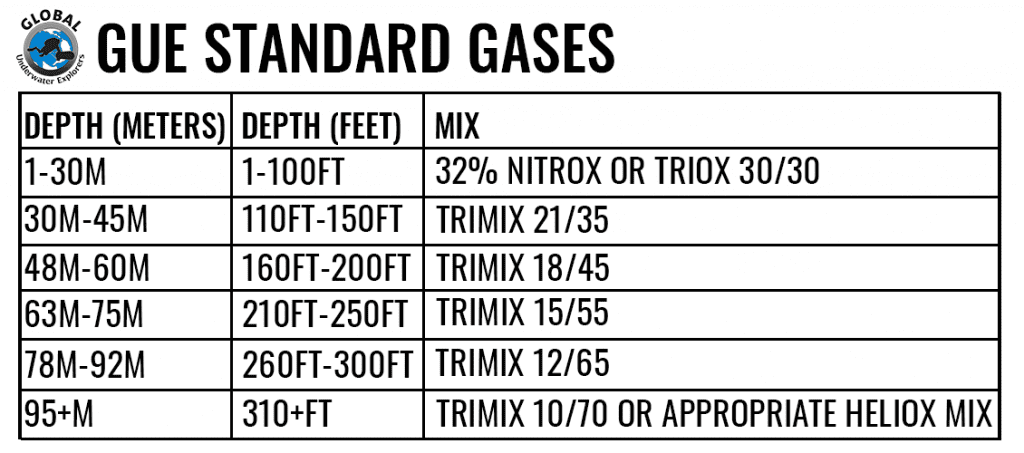
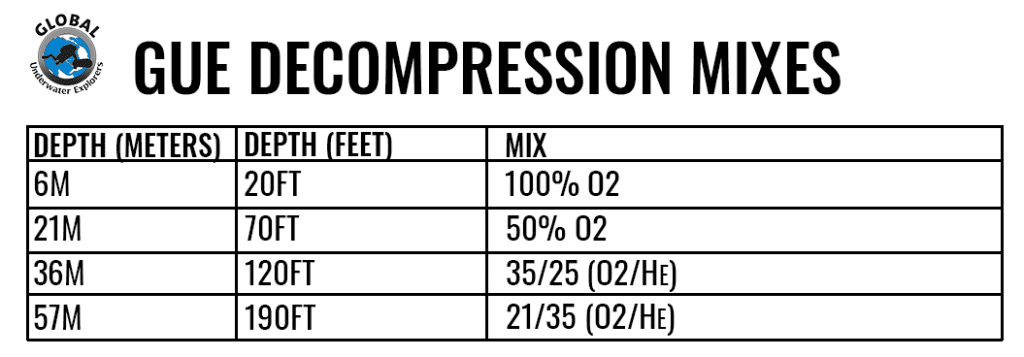
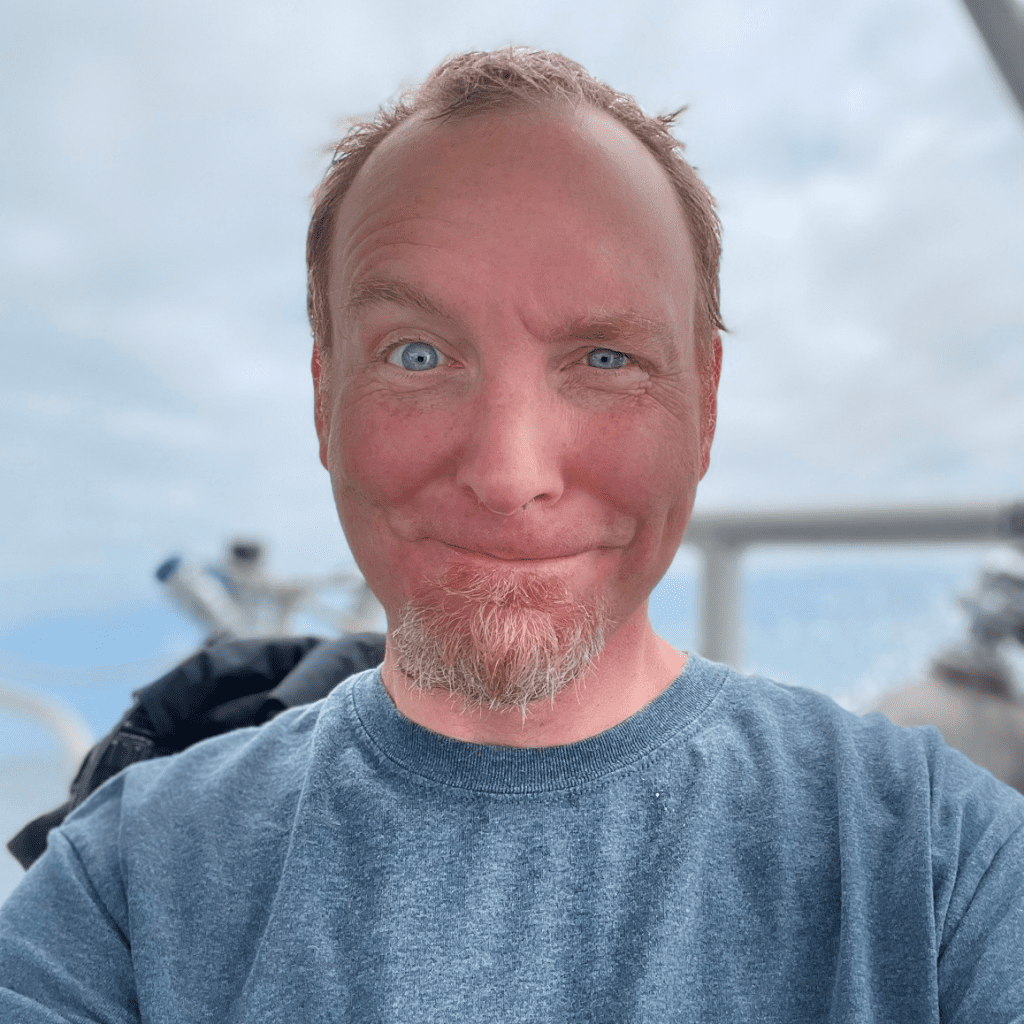
Born in France but hailing from Italy via England, Francesco’s passion for the ocean was ignited early on by the work of Jaques Cousteau, and Luc Besson’s film, The Big Blue. Growing up in the seaside village of Portofino, Italy, Francesco spent just about every daylight hour of his summers freediving. In his 20s and 30s, he found himself locked in a recording studio in London or Los Angeles making records for the likes of Queen and Duran Duran as well as Korn, Stone Sour, Avatar, and others. Francesco rediscovered the ocean on a trip to Kona, which is where his scuba journey began in earnest. Since then, he has averaged over 200 dives a year cultivating his own skills. Once he found GUE, he worked his way through the curriculum and became a GUE instructor in 2019. That year, the passionate and exacting polymath was one of the busiest GUE instructors in Los Angeles. He is now a Tech One Instructor. Some say you can occasionally hear him singing to the fish.

























